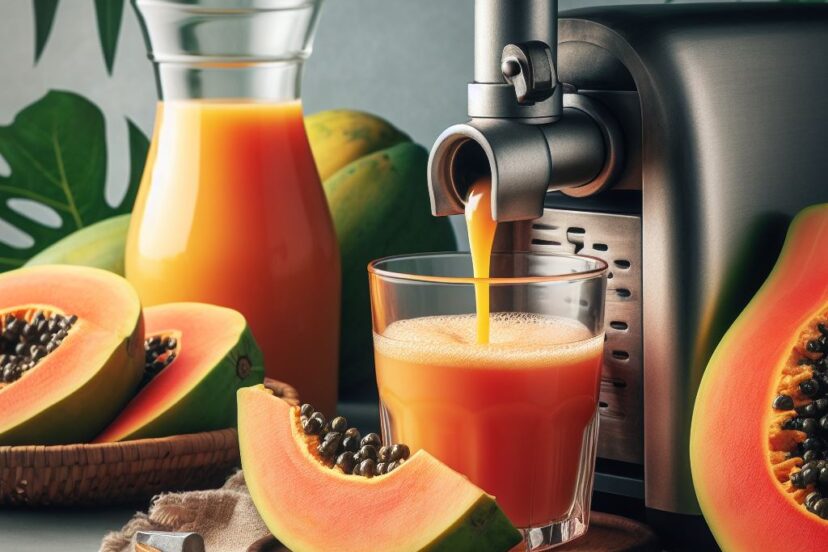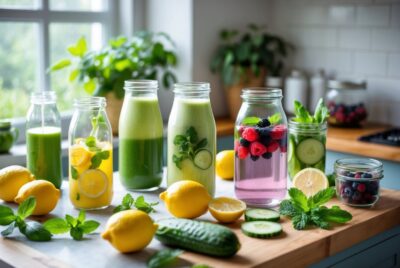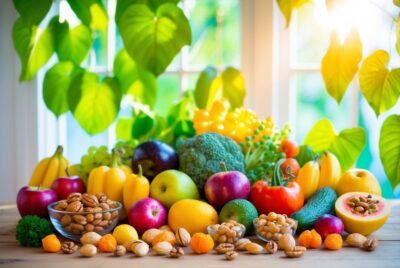Juicing a Papaya: Simple Techniques for a Tropical Treat
*We may earn a commission for purchases made using our links. Please see our disclosure to learn more.
Juicing a Papaya: Simple Techniques for a Tropical Treat
I’ve found juicing to be a fantastic way to enjoy the flavors and nutrients of various fruits and vegetables, and papaya is no exception. As a fruit rich in vitamins A and C, as well as digestive enzymes such as papain, juicing a papaya offers a refreshing way to boost health and digestion. Its tropical sweetness and creamy texture make it a delightful ingredient for any juicing enthusiast.
When preparing papaya juice, I always ensure to wash the fruit thoroughly, removing any external contaminants and dirt. It’s important to slice the papaya safely and efficiently, discarding the seeds and fibrous center. The vibrant orange flesh of the papaya promises a nutrient-dense juice, which is not only a pleasure to drink but also an easy way to obtain a wealth of health benefits.
Consuming papaya in juice form allows for quick absorption of its antioxidants and fiber, although the juicing process may reduce the amount of fiber compared to eating the whole fruit. Regardless, I appreciate the convenience of juicing, as it fits seamlessly into a busy lifestyle, providing a quick and tasty source of essential nutrients. Plus, the enzyme papain found in papaya is known for aiding digestion, making papaya juice a smart choice for those seeking to maintain a healthy digestive system.
Selecting the Perfect Papaya

When I choose a papaya for juicing, I look for fruit that promises the best flavor and the richest nutrients. My success hinges on identifying ripe papayas and understanding the benefits they offer.
Identifying a Ripe Papaya
Fruit that is ripe is crucial for a quality juice. I check for a few indicators:
- Color: A ripe papaya usually has a vibrant orange or yellow hue. I look for a uniform color, steering clear of any dark spots or bruises.
- Texture: I gently press the skin. It should yield slightly to pressure, a sign that the fruit is ripe.
- Aroma: Ripe tropical fruit emits a fragrant, sweet scent. If I smell the base of the papaya and it’s sweet, I know it’s ripe.
Benefits of Using Ripe Fruits
Using ripe papayas isn’t just about the tropical flavor; it’s also about the nutrients:
- Flavor: The sweet, robust flavor is strongest when the fruit is ripe, ensuring my juice will be delicious.
- Nutrients: Ripe papayas are a treasure trove of vitamins and enzymes. I get the most nutrients like vitamin C and folate from fruit at its peak ripeness.
Preparation Before Juicing

Before I begin the juicing process, I ensure that my papaya is properly prepared. This includes cutting and coring the fruit, as well as thoroughly cleaning it to eliminate any potential contaminants.
Cutting and Coring when Juicing a Papaya
To start, I wash the papaya under running water to get rid of any dirt on the skin. Using a sharp knife, I slice off the top and bottom of the fruit to provide a stable base for peeling. I carefully peel away the skin, cutting deep enough to remove the green part without wasting any of the sweet flesh. Once peeled, I cut the papaya in half lengthwise and use a spoon to scoop out the seeds. The seeds are discarded unless I have another purpose for them, such as making a dressing or a marinade, because they’re not needed for the juice.
The Importance of Cleaning
Cleaning is not just about aesthetics; it’s crucial for health reasons as well. I always clean my work surface and utensils before starting any food preparation in the kitchen. In addition, washing fruits like papaya under clean running water is a vital step to remove any lingering bacteria or chemicals. Although the peel is not consumed, it comes into contact with the knife and could contaminate the flesh if not washed. If I won’t be using the papaya right away, I store it in the refrigerator to maintain its freshness and prevent any health hazards. The fridge also helps in keeping the papaya cool, which can provide a more refreshing juice.
Juicing Techniques when Juicing a Papaya

When I make papaya juice, I use specific techniques that ensure a smooth texture and preserve the tropical flavor of the fruit.
Using a Blender or Juicer
Blender: To create a delicious papaya smoothie, I start by cutting the papaya in half and scooping out the seeds. Then, I peel the skin and chop the fruit into cubes. I place the papaya cubes in a blender, adding a bit of water or coconut water for easier blending. For a single serving, a half-cup of liquid usually suffices. I blend until the mixture is smooth. If I prefer a thinner consistency, I can add more liquid.
- Ingredients for Blender:
- Papaya cubes
- 1/2 cup water or coconut water (adjust as needed)
Juicer: If I’m using a juicer, the preparation is similar: halve the papaya, remove the seeds, and peel. I then cut the fruit into pieces that fit my juicer’s feed tube. I process the papaya until all the juice is extracted, discarding the pulp unless I plan to use it for another recipe.
- Ingredients for Juicer:
- Papaya pieces
Enhancing the Juice
I find that the natural sweetness of papaya can be enhanced with the addition of a few ingredients. A touch of honey, lime juice, or lemon juice can brighten the flavor. When I am craving something more complex, I may add a hint of fresh ginger for a slight kick. To sweeten the juice without overdoing it, I add the sweetener gradually, tasting as I go.
- Optional Enhancers:
- 1 teaspoon of honey or sugar (adjust to taste)
- A squeeze of lime or lemon juice
- A small piece of ginger (grated or sliced)
When serving, pouring the juice over ice cubes refreshes the drink, offering a cool tropical treat. If I’m preparing the drink for later, I store it in the refrigerator to keep it chilled.
Juicing a Papaya: Serving and Preservation

When juicing ripe papayas, it’s important to consider how to store the juice effectively and serve it in a way that enhances its natural flavors. I’ll guide you through the best practices for storing your homemade papaya juice and provide creative serving suggestions, along with insights into the health and nutritional benefits of this vibrant tropical drink.
Storing Papaya Juice
Storing papaya juice properly is critical to maintain its freshness and nutritional qualities. I recommend using an airtight glass container to prevent oxidation and store the juice in the refrigerator immediately after preparation. Papaya juice is best enjoyed within 1-2 days to ensure optimal taste and nutrient preservation. If necessary, it can be frozen for extended shelf life, though this might alter the taste and texture slightly upon thawing.
- Refrigerator Storage: Up to 48 hours in a sealed glass container.
- Freezer Storage: Freeze in an airtight container for up to one month.
Creative Serving Ideas
To serve papaya juice in a way that’s both refreshing and appealing, consider enhancing its natural tropical flavors with garnishes or mix-ins. Serve the juice over ice for an instant cool-down, or blend it with other fresh fruits for a more complex taste profile. For an elegant touch, use a chilled glass and garnish with a slice of papaya or a sprig of mint.
- Smoothie: Blend with banana and mango for a thicker, smoothie-like consistency.
- Cocktail: Mix with a splash of sparkling water for a fizzy, non-alcoholic treat.
Health and Nutrition Insights when Juicing a Papaya
Papaya juice is a powerhouse of nutrition, offering a rich source of vitamins, fiber, and antioxidants, which can contribute to a healthy immune system and improved digestion. Regular consumption of papaya juice might help with reducing inflammation due to its nutrient-rich composition.
- Vitamins: High in vitamin C and vitamin A.
- Digestive Support: Contains the enzyme papain, which aids digestion.
- Antioxidant Properties: Packed with antioxidants that may protect against certain diseases by neutralizing harmful free radicals.
By adhering to these storing and serving practices, I can ensure my papaya juice retains its best qualities and health benefits.
Frequently Asked Questions
In this section, I cover some of the most common inquiries about juicing papaya, ranging from its health benefits to preparation techniques.
1. What are the health benefits of juicing papaya?
Juicing papaya provides a rich source of vitamin C, vitamin A, fiber, and antioxidants, supporting overall health and boosting the immune system.
2. Can papaya seeds be included when making juice?
While papaya seeds are edible, they have a sharp, peppery taste which might not be pleasant in juice. Most people prefer to remove them before juicing.
3. How does papaya juice contribute to a weight loss diet?
Papaya juice is low in calories and high in dietary fiber, which can help in feeling full for longer periods, thus contributing to weight management when included as part of a balanced diet.
4. What fruit combinations work well with papaya juice?
Papaya juice pairs well with pineapple, mango, and banana for a tropical flavor profile and additional nutritional benefits, such as extra vitamins and enzymes.
5. How should papaya be prepared for juicing in a home juicer?
To prepare papaya for juicing, wash it thoroughly, peel off the skin to remove any bitterness, and cut the flesh into smaller pieces that fit into the juicer. Remember to discard the seeds if you prefer a smoother juice.




